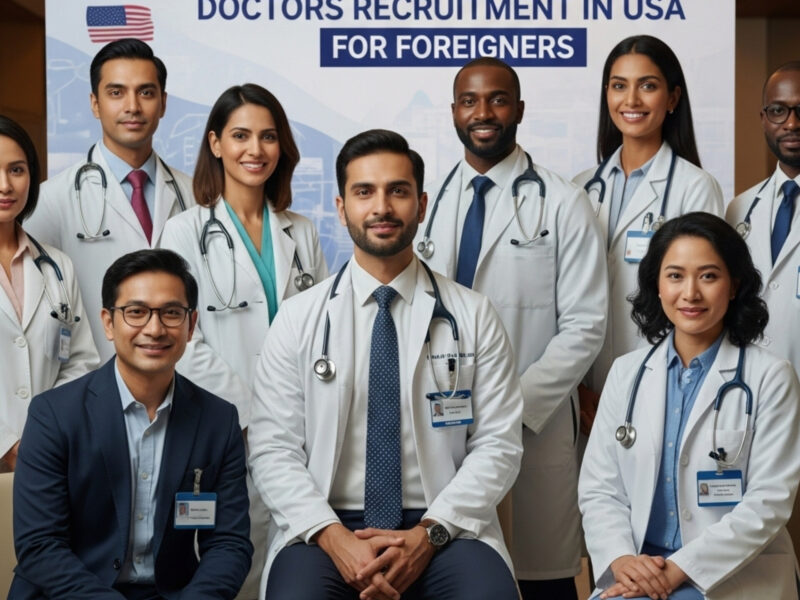The United States is one of the most sought-after destinations for medical professionals worldwide, thanks to its advanced healthcare system, high earning potential, and vast opportunities for specialization and career growth. For foreign-trained doctors, the pathway to practicing medicine in the U.S. is rigorous but highly rewarding.
In this blog post, we explore doctor recruitment in the USA for foreigners, covering the steps, requirements, visa options, challenges, and available opportunities. Whether you’re a medical graduate from abroad or a licensed doctor aiming to relocate, this guide will help you understand how to start your journey.
Why Work as a Doctor in the USA?
- Attractive Salary
U.S. doctors are among the highest-paid professionals globally. Depending on specialization and location, salaries can range from $150,000 to over $400,000 per year. - Advanced Healthcare Facilities
The U.S. is known for cutting-edge medical technology, research institutions, and top-tier hospitals. - Career Development
Physicians in the U.S. have access to specialized training, research roles, and leadership opportunities in healthcare. - High Demand for Medical Professionals
Due to an aging population and physician shortages in rural and underserved areas, foreign-trained doctors are increasingly in demand.
Pathway for Foreign-Trained Doctors
To practice medicine in the United States, foreign-trained doctors must complete several steps to meet licensing and immigration requirements:
1. Educational Credential Verification
- Register with the Educational Commission for Foreign Medical Graduates (ECFMG).
- Submit your medical school diploma, transcripts, and credentials for verification.
2. USMLE Exams
- Pass the United States Medical Licensing Examination (USMLE):
- Step 1: Tests basic medical sciences.
- Step 2 CK: Clinical knowledge assessment.
- Step 3 (after residency): Independent practice readiness.
3. English Language Proficiency
- Non-native English speakers may be required to pass the TOEFL or another recognized test to prove English proficiency.
4. Apply for Residency
- Use the Electronic Residency Application Service (ERAS) to apply to U.S. hospitals.
- Participate in the National Resident Matching Program (NRMP) to secure a placement.
5. Complete a Residency Program
- Even if you have practiced for years abroad, you must complete a U.S. residency program in your specialty to gain licensure.
6. Obtain State Medical Licensure
- After residency, apply for licensure through the medical board of the state where you plan to work.
7. Visa Sponsorship
- Secure a work visa to practice legally in the U.S. (discussed below).
Visa Options for Foreign Doctors
- J-1 Visa (Exchange Visitor Visa)
- Common for residency and fellowship participants.
- Requires doctors to return to their home country for two years after completion, unless a waiver is granted.
- H-1B Visa (Specialty Occupation Visa)
- Can be used by physicians who have passed USMLE Step 3 and secured employment.
- Easier path for permanent residency (Green Card) compared to J-1.
- O-1 Visa (Individuals with Extraordinary Ability)
- Suitable for doctors with significant achievements in medicine or research.
- Green Card (Permanent Residency)
- Employers can sponsor foreign doctors for a Green Card, often after working under a temporary visa like H-1B.
Where Are Doctors in High Demand in the USA?
While urban centers have competitive job markets, rural and underserved areas often have shortages of qualified physicians. These areas are more likely to sponsor visas and offer incentives like student loan repayment or sign-on bonuses.
Specialties in high demand include:
- Family medicine
- Internal medicine
- Psychiatry
- Pediatrics
- Geriatrics
- Emergency medicine
Top Recruitment Agencies and Employers for Foreign Doctors
Here are a few recruitment platforms and organizations that help international medical graduates (IMGs) find work in the U.S.:
- Global Medical Staffing
- CompHealth
- Merritt Hawkins
- Health eCareers
- Jackson & Coker
- The Federation of State Medical Boards (FSMB)
Hospitals and academic institutions like the Mayo Clinic, Cleveland Clinic, Johns Hopkins Hospital, and Mount Sinai Health System often hire foreign-trained doctors, particularly for research and residency programs.
Common Challenges and How to Overcome Them
- Lengthy Process
- The process can take several years. Start early, ideally before graduating from medical school.
- Financial Costs
- USMLE exams, application fees, and credential evaluations are costly. Some hospitals offer sponsorships or reimbursements.
- Residency Competition
- Many IMGs face tough competition. Boost your application with research experience, strong recommendation letters, and high USMLE scores.
- Cultural and Clinical Adaptation
- Adjusting to the U.S. healthcare system may take time. Participate in clinical electives or observerships to gain familiarity.
Tips for Success
- Begin credentialing and exam preparation as early as possible.
- Network with other IMGs and attend medical career fairs.
- Apply widely to residency programs and tailor your personal statements.
- Stay up to date with immigration policy changes related to healthcare workers.
- Consider applying through programs like Conrad 30 Waiver Program, which helps waive the J-1 return requirement for doctors working in underserved areas.
Conclusion
While the road to becoming a licensed physician in the United States as a foreigner is demanding, it offers exceptional career opportunities and long-term benefits. With the proper preparation, patience, and persistence, foreign-trained doctors can successfully navigate the U.S. recruitment system and build a fulfilling medical career.
If you are committed to practicing medicine in the United States, start planning now. The demand for skilled and compassionate doctors is growing, and your expertise could be a valuable asset in improving healthcare outcomes across the country.
